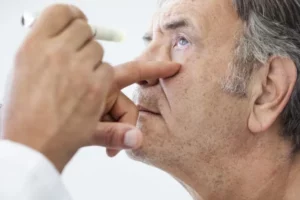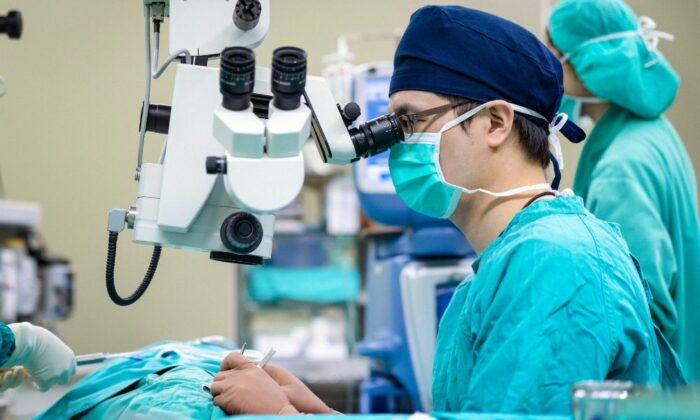So, after a successful RLE surgery, the spotlight now shifts to the pivotal phase that could very well dictate the longevity of your improved vision – THE AFTERCARE. Now is the time to take proactive steps to maintain the eye health that has been so finely restored. The journey to revitalized eyesight doesn’t end the moment you step out of the surgery room; in fact, it just begins.
So, join us as we walk you through an insightful guide, intricately designed to equip you with the knowledge and strategies to maximize your RLE surgery success. Let’s begin!
Contents
Understanding the Importance of RLE Surgery Aftercare

Refraction Lens Exchange (RLE) surgery, a groundbreaking procedure that replaces your eye’s natural lens with an artificial one, marks the advent of a new chapter in your visual journey. This surgical endeavor, while potent in offering a remarkable improvement in vision, is only the beginning. The real crux of this journey lies in the meticulous aftercare, an aspect often overshadowed yet fundamental in sculpting successful outcomes.
Aftercare post-RLE surgery is not just a protocol, but a commitment to fostering the health and functionality of your eyes. Much like a newly planted sapling requires constant attention and nurturing to grow into a robust tree, your eyes demand a similar kind of dedication and care. It’s during this period that your eyes start adapting to the new lenses, setting the foundation for your future visual experiences.
The steps and measures you take during this phase could be the deciding factors in whether your surgery yields long-lasting benefits.
The Immediate Aftercare: First 24 Hours

The initial 24 hours following your RLE surgery hold a significant place in the recovery timeline. It’s a critical period where your eyes begin to acclimate to the new lenses. Here, we provide you with a blueprint that outlines the necessary precautions and steps to undertake, fostering a conducive environment for healing and recovery.
Rest and Relax
Right after the surgery, it’s paramount to give your eyes the rest they rightfully deserve. Your vision might be slightly blurred and sensitive to light; hence, it is advised to lie down in a dimly lit room and close your eyes for several hours. This phase is all about relaxation, steering clear from activities that can strain your eyes.
Medication Adherence
Post-surgery, your surgeon would prescribe a set of medications, mainly in the form of eye drops, to prevent infection and control inflammation. It’s essential to use these medications as directed, meticulously following the schedule laid out by your healthcare provider.
Steering Clear of Physical Exertion
During this period, avoid indulging in activities that involve physical exertion or straining your eyes. Activities such as reading, watching TV, or using a computer should be postponed. Your primary focus should be on giving your eyes time to heal naturally without any external pressures.
Hygiene Matters
Maintaining a high standard of hygiene is vital. Washing your hands thoroughly before touching your eyes or administering eye drops will ward off potential infections. Furthermore, resist the urge to rub or touch your eyes, as it can cause irritation or harm the healing process.
Protective Gear
Your surgeon might provide you with a protective shield or eyewear to guard your eyes against dust and other irritants. Wearing this gear, especially while sleeping, can prevent inadvertent rubbing or pressure on your eyes.
Seek Immediate Help if Necessary
While complications are rare, they can occur. If you experience acute pain, vision loss, or any other sudden adverse symptoms, do not hesitate to contact your healthcare provider immediately.
Remember, this initial phase of recovery lays the groundwork for the weeks to come. Being vigilant and adhering to the guidelines can potentially result in a seamless and swift recovery.
Week One: Monitoring and Care
 As you venture into the first week post-RLE surgery, your eyes will be undergoing a significant phase of adjustment and healing. This week serves as a transitional period where you will notice gradual improvements in your vision and overall eye health. Let’s delve into the critical aspects that constitute monitoring and care during this pivotal time.
As you venture into the first week post-RLE surgery, your eyes will be undergoing a significant phase of adjustment and healing. This week serves as a transitional period where you will notice gradual improvements in your vision and overall eye health. Let’s delve into the critical aspects that constitute monitoring and care during this pivotal time.
- Recognizing and Managing Symptoms
During the first week, you may experience a myriad of symptoms like mild discomfort, irritation, or fluctuating vision. However, understanding how to manage these symptoms can make this period more comfortable. Utilize prescribed eye drops regularly to alleviate irritation and dryness. Keeping your eyes moist is key to preventing discomfort.
- Routine Follow-Up Appointments
Scheduled follow-up appointments are a cornerstone of successful recovery. These visits allow your surgeon to monitor the healing process closely and make necessary adjustments in your treatment plan. It’s essential to attend these appointments diligently, as they serve as a platform to address any concerns or questions you might have.
- Restricting Certain Activities
During this week, it’s prudent to continue avoiding activities that can strain or potentially harm your eyes. Your surgeon will provide a comprehensive list of dos and don’ts to guide you during this period.
- Safeguarding Your Eyes
Your eyes remain vulnerable during this initial week, and safeguarding them from potential irritants is vital. Continue wearing protective eyewear, especially in environments where your eyes might be exposed to dust, smoke, or other irritants.
- Nutritional Support
A balanced diet can play a supportive role in your recovery. Incorporating foods rich in vitamins and minerals, especially Vitamin C and E, can promote eye health. Hydration is equally important; ensure to intake a sufficient amount of fluids daily.
Long-term Aftercare Post RLE Surgery: Protecting Your Vision
 After successfully navigating the initial stages of recovery, your focus should now shift towards the long-term maintenance and protection of your newly acquired vision. Let’s explore how you can keep your vision crystal clear and your eyes healthy in the long run.
After successfully navigating the initial stages of recovery, your focus should now shift towards the long-term maintenance and protection of your newly acquired vision. Let’s explore how you can keep your vision crystal clear and your eyes healthy in the long run.
- Regular Eye Check-ups
Maintain a schedule of regular visits to your eye doctor to monitor the health of your eyes and retain the results of your RLE surgery.
- Protective Eyewear
Always ensure to shield your eyes with appropriate protective eyewear. Sunglasses with UV protection are particularly beneficial in guarding your eyes against harmful UV rays.
- Screen Time Management
Adopt habits like the 20-20-20 rule, where you take a 20-second break to view something 20 feet away every 20 minutes. This simple practice can go a long way in preventing digital eye strain.
- Avoiding Smoking
If you are a smoker, working towards quitting can be a substantial step in protecting your vision.
- Sufficient Rest
Ensuring that your eyes get sufficient rest is an underrated aspect of eye care.
Signs of Complications: When to Seek Help
 While complications are relatively rare, early detection can prevent further issues and facilitate a smoother recovery journey. Here, we outline some signs and symptoms that might indicate complications, and under what circumstances you should seek immediate medical help.
While complications are relatively rare, early detection can prevent further issues and facilitate a smoother recovery journey. Here, we outline some signs and symptoms that might indicate complications, and under what circumstances you should seek immediate medical help.
- Unusual Pain or Discomfort
While it is normal to experience a certain level of discomfort immediately following the surgery, persistent or escalating pain is a cause for concern.
- Sudden Vision Changes
Any sudden or drastic changes in your vision post-surgery should not be taken lightly. This could include a significant loss of vision, sudden onset of blurred vision, or seeing flashing lights or floaters.
- Signs of Infection
Infections, though rare, are a serious complication that requires prompt intervention. Signs to watch out for include increased redness, swelling, discharge, or a constant feeling of something being stuck in your eye.
- Excessive Tearing or Sensitivity to Light
While some level of sensitivity to light is expected initially, if you find this symptom worsening or persisting for an extended period, it might indicate a complication.
- Elevated Eye Pressure
Though not something you can notice on your own, during your follow-up visits, the doctor might check for elevated eye pressure, which can be an indication of potential complications.
Knowing when to seek help can be a crucial aspect of your recovery process. Remember, it is always better to err on the side of caution when it comes to your eye health.
Conclusion
As we reach the conclusion of our insightful journey into the world of RLE surgery and its aftercare, we must emphasize that the path to sustaining your newfound visual clarity is paved with conscientious aftercare. At Eye Mantra, we are steadfastly committed to not only providing top-notch surgical solutions but also nurturing a partnership that extends well into your recovery phase.
With our team of experienced professionals, state-of-the-art facilities, and a legacy of trust and excellence, you can rest assured that you’re in capable hands every step of the way.
So, embark on this transformative journey with Eye Mantra, where we blend cutting-edge technology with personalized care, sculpting a future where your vision knows no bounds.
Are you looking for RLE surgery? Experience the freedom of clear vision with RLE Surgery at EyeMantra. Book your free appointment now at 9711116605



